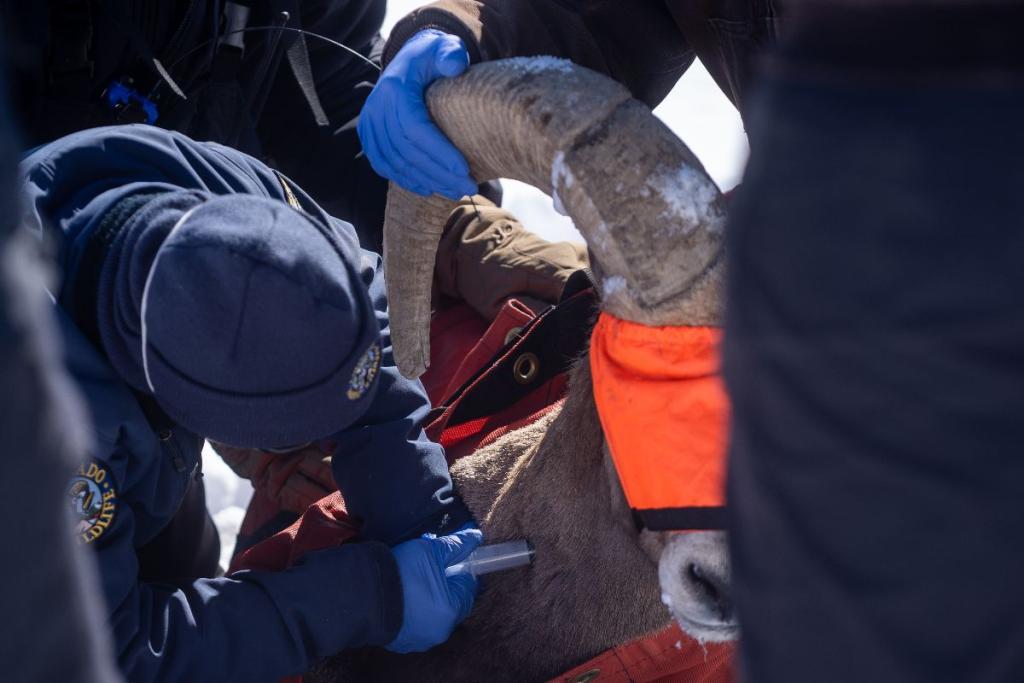CPW embarks on bighorn sheep study in Cochetopa Canyon

 John Livingston
John LivingstonSouthwest Region Public Information Officer
970-759-9590 / [email protected]

CPW aims to place GPS collars on 30 bighorn sheep split between rams (males) and ewes (females). Researchers and biologists will then monitor the sample of bighorn sheep during the next two to three years to map bighorn range and study population dynamics within the herd in Cochetopa Canyon.
One key element of the study is to track bighorn sheep forays and dispersals. Forays refer to more brief excursions before returning back to the herd. A dispersal occurs when bighorns journey away from their herds and do not return.
“The goal is to derive a more accurate abundance estimate, examine herd health and disease profiles and opportunistically document detailed information on forays and dispersals,” said CPW biologist Kevin Blecha.
Cochetopa Canyon is native bighorn habitat, but the herd was extirpated in the 1800s and early 1900s following European settlement. The herd was reestablished by CPW in 1995 when 24 bighorn sheep were transplanted to the canyon from the Taylor Canyon herd roughly 25 miles north.
“This is a burgeoning herd that has expanded from 24 animals transplanted in 1995 in an effort to recolonize historic habitat to 140-180 bighorns on the landscape today,” said CPW senior terrestrial biologist Jamin Grigg. “This project helps inform our knowledge of their habitat use and movement patterns.”
CPW has documented several bighorn dispersal and foray events radiating away from Cochetopa Canyon during the past few summers, which indicates the herd may be spilling over its available habitat.
While some bighorns may make forays of 10 to 20 or even 30 miles regularly, some rare incidences have documented bighorn dispersals of hundreds of miles and even across state boundaries. Rams will typically travel further distances and at a higher rate than ewes, Grigg said.
“While many studies have been conducted focusing on ewes, few studies focus so heavily on rams,” Blecha said. “Rams are interesting because they are more likely to make long distance movements through a short-term foray (excursion) or a dispersal (permanent movement) away from a herd.
“The bighorn population in Cochetopa Canyon has done very well in recent years, and so this is a good place to get a better understanding of these outward movements away from the herd.”
A herd’s health is greatly dependent on the amount of available habitat. Historically, some Colorado bighorn populations likely exceeded 1,000 animals. However, current herds in places such as Cochetopa Canyon have relatively limited habitat, and there is concern that the population may potentially be approaching its ecological carrying capacity.
Blecha said the Cochetopa Canyon population is already among the top 10 most densely populated bighorn herds in the state based on the number of animals versus available habitat. He said the herd is also somewhat unique because it inhabits relatively low-elevation habitat year-round compared to alpine bighorn populations.
“Historically, when a herd gets to the higher end of the density spectrum here in the Gunnison Basin, they become poised for a potential crash,” Blecha said. “With bighorn sheep, wildlife managers pay particular attention to disease and minimizing the potential for disease transmission because these animals are highly susceptible to various pathogens. When there is the kind of population growth like we’ve seen here in Cochetopa Canyon, the sheep will expand outward and are more likely to foray. That is a natural process necessary for genetic exchange and pioneering into novel habitats, but it can present problems in terms of potentially increasing the risk of coming into contact with novel pathogens that may reduce herd vigor and viability.”
To capture bighorn sheep for this project, CPW is using helicopter net gunning as well as ground-darting from vehicles. This work is typically done during the winter months when temperatures are cooler, sheep are in high concentrations on winter range and ewes are not supporting dependent young.
Data collected will help CPW derive an estimate of population size and understand what habitats the herd utilizes most. Once that core range is more defined, CPW will then be able to better understand what the foray and dispersal rate is radiating away from that herd.
Grigg said that information will help inform CPW’s Herd Management Plans, hunting license allocations, Federal land management planning, as well as informing Best Management Practices for bighorn sheep not only in the Gunnison area but in similar bighorn herds occupying isolated canyons.
“We’ve got strong evidence of forays and dispersals happening here over the last few summers with a good number of young looking bighorns heading away from this herd,” Blecha said. “We really don’t know a lot about this other than the fact they do it. It isn’t always a good thing because of everything they can come in contact with when dispersing or foraying, so we want to know more about this phenomenon.”
BOTTOM: Bighorn sheep from the Cochetopa Canyon herd are set up with GPS collars. CPW will track their movements for several years to get an understanding of dispersals and forays.



Colorado Parks and Wildlife (CPW) is an enterprise agency, relying primarily on license sales, state parks fees and registration fees to support its operations, including: 43 state parks and more than 350 wildlife areas covering approximately 900,000 acres, management of fishing and hunting, wildlife watching, camping, motorized and non-motorized trails, boating and outdoor education. CPW's work contributes approximately $6 billion in total economic impact annually throughout Colorado.
DISCLAIMER: The Colorado Parks and Wildlife (CPW) website maintains press releases containing historical information that may no longer be accurate. Press releases are dated, which should be noted to determine whether the information provided is current. Please review our current regulations and brochures for up-to-date information.